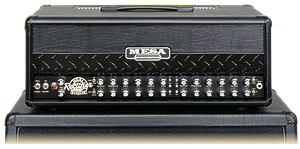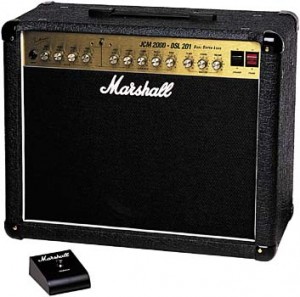 Although Mesa first released its Roadster series of amp heads and combos in 2006, it wasn’t until 2008 that I finally tried one. Playing it in the store, I was impressed enough to make the purchase. Based on my playing time since then in various environments, volumes, etc., and coupled with the many experiences of other Boogies I’ve played and owned through the years, to me the Mesa Roadster is THE best amp Mesa has ever produced. No contemporary multi-channel amp I’ve ever played previously had delivered such a consistently great range of tones across each of its channels – suitable for any style of music and user-friendly with any guitar.
Although Mesa first released its Roadster series of amp heads and combos in 2006, it wasn’t until 2008 that I finally tried one. Playing it in the store, I was impressed enough to make the purchase. Based on my playing time since then in various environments, volumes, etc., and coupled with the many experiences of other Boogies I’ve played and owned through the years, to me the Mesa Roadster is THE best amp Mesa has ever produced. No contemporary multi-channel amp I’ve ever played previously had delivered such a consistently great range of tones across each of its channels – suitable for any style of music and user-friendly with any guitar.
Read More »
Category Archives: Amplifiers
My Love/Hate Mesa/Boogie Story, Part I: Drinking the Boogie Kool Aid
Take a journey with me while I reminisce back to the beginning where my love for Mesa Boogie amps began. During the summer of 1984, I was a wide-eyed 12-year old teenager who was passionate about the hard rock and metal music available at the time. From the bands that had broken through to my US ears from overseas such as Judas Priest, Iron Maiden, Def Leppard and the Scorpions, to the Los Angeles rock and metal scene with bands like Van Halen, Motley Crue, RATT, Dokken, and Quiet Riot, to even further underground metal acts at the time including Metallica, Slayer, Obsession, and Venom, there was a LOT for my young ears to take in and listen to. Just about every dollar of money I earned for chores around the house went toward buying new records (yes,on vinyl) or guitar and music magazines including Circus, Hit Parader, Guitar for the Practicing Musician, and Guitar World.
Read More »
THD Electronics Hot Plate Attenuator
It’s not a secret that nothing beats the sound of a great guitar tube amp cranked up. When a tube amp is driven to overdrive, rich and musical even-ordered harmonics flow in abundance and the amplifier seems to take on a new sense of dynamic character that responds better to a player’s touch. It is this feel that gives a tube amp an organic and natural sense, while solid-state amplifiers are considered more sterile in sound because of the lack of this response or harmonics.
The age-old problem has been getting the great tube amp sound at lower and more realistic levels. As the majority of musicians play relatively small clubs and in even smaller practice rooms, only the minority (i.e. those famous guitarists!) get the real opportunity to play these tube amps at the volumes that they sound best. As a result, many of our classic and much beloved Marshall, Fender, and Vox amplifiers are often seen used with distortion and fuzz boxes to compensate. While my personal belief is that these distortion and fuzz boxes are useful in some applications, they are certainly not the best way to achieve great tone when used strictly as the sole source of distortion.
Read More »
Groove Tubes 6L6GE “Made in U.S.A” Tube
“Made in U.S.A….” For much of what was produced in this country in the past, that term really indicated more than just a manufacturing location. It also indicated pride and true quality of products that were head and shoulders above the rest. In the world of musical instruments, “Made in U.S.A.” today still means the mark of the best quality, but still most expensive instruments made. This wasn’t always the case for many products from the mid-to-late ’70s as quality took a real slide while foreign-run companies made our products look like jokes. But, that said, it is nice to see that today, the quality of products that are made in the U.S. has again dramatically improved. In many aspects of production – for example, the boutique amplifier, guitar, and effects builders based in the U.S., it seems that the sense of pride and workmanship has returned in full form. I can’t think of a better time to have such a great selection of new gear from so many great companies. Yes, there will still be some who say older is “always” better, but I don’t buy that. There are some fantastic guitars, amps, and effects being produced, with strict attention to the details and you’ve got a heck of a lot more choice these days then you did back in the ’50s and ’60s.
Read More »
Interview with Groove Tubes President Aspen Pittman
A short while back, LegendaryTones spent some time with Groove Tubes President Aspen Pittman to discuss and learn about the current state of tubes today as well as to learn more about GT’s new U.S.A. production tubes and future plans. Enjoy!
Read More »
Vox Valvetronix AD120VTX Amplifier & Vox Tonelab
The Vox name should be familiar to virtually any guitarist that’s taken that quest for tone or is a regular visitor to this site. That name is of course associated with some of the most famous amplifiers of all time, including the AC15 and AC30. The AC15 had its beginnings in the late 1950’s with the AC30 following soon afterward – and now, even after more than 50 years with the same circuit design at their heart, these are still two amps that continue to be revered for their tone and are as musically useful today as they’ve ever been.
So when Vox announced two years ago that it was moving toward the production of modeling amplifiers, no doubt there was skepticism about what the final product would be like. I’m sure mutterings of “Why mess with a good thing?” were heard and told as well as how a company rooted in “older technology” would do with the creation of amplifiers based on new technology and engineering requirements.
Read More »
Mojave AmpWorks PeaceMaker and Plexi 45 amp heads
Most readers at this site understand I’m a big time “amp nut” – with a special love for old Marshalls in particular. Some readers have even complained, “Too much Marshall!” in terms of content and asked me to pay attention to some other amps out there.
Well, o.k., I’m going to move away from the Marshalls, but not too far for the moment as the Mojave AmpWorks Peacemaker and Plexi 45 certainly share the Marshall heritage – in the case of the Plexi 45, its circuit is as dead-on of a true JTM 45 clone as you’ll find in any new amp built today. The Peacemaker however, adds some twists to the legendary Marshall tone, which we’ll dig into shortly.
Read More »
Interview with Marshall VP Mitch Colby on Marshall HW Series
 Recently at the past 2004 NAMM show, Marshall formally unveiled its latest line of amplifiers – vintage recreations called the Hand Wired series. For many vintage amp tone enthusiasts (myself included), this was just the move that we had hoped Marshall would someday make.
Recently at the past 2004 NAMM show, Marshall formally unveiled its latest line of amplifiers – vintage recreations called the Hand Wired series. For many vintage amp tone enthusiasts (myself included), this was just the move that we had hoped Marshall would someday make.
Read More »
Vacuum Tube Basics
While digital modeling has caught the attention of many players today, tubes and tube amps are far from dead. And even with the new digital modeling technology, which indeed is designed to try and emulate the sounds of world-famous tube amps from the past and present, there seems to be a resurgence in the number of tube amp options that are out there. One of the strengths of a good tube amp is its ability to respond to the dynamics of a guitar player’s picking attack when a tube is being overdriven. In addition, no solid-state or digitally modeled amplifier sounds as good as a tube amp when played over a loud band. In fact, it is at loud volumes where tube amps really come alive, while solid state and digitally modeled amps will often become thin and have harsher high-frequency emphasized tones.
Since tube amps and tubes themselves are certainly here to stay, I thought it would be appropriate to talk about vacuum tube basics. This article’s purpose is simple: to discuss what tubes do, describe the different tube types and how they each sound. Afterward, we’ll discuss briefly about what to look for when shopping for tubes and getting them installed.
Read More »
Marshall’s All-Tube 20 Watt Combo – JCM 2000 DSL-201
Throughout its history spanning nearly 40 years, Marshall has continued to produce amplifiers that have been successfully adopted and used by musicians worldwide. As the years progressed, Marshall amplifiers came offered with a variety of additional features to suit the needs and requests of musicians through changing times. Nowadays, a fully equipped Marshall incorporates two or three channels, reverb, an effects loop, speaker-emulated direct outs, additional preamp stage gain, as well as a wide array of independent tones and volume controls for each available channel.
 Power requirements have changed as well. With today’s modern p.a. systems being more than suitable to run the entire band, it is no longer required to run a Marshall stack at full volume and save the p.a. system “just for the vocals”. Today’s guitarists playing club gigs will often mike up through house sound, hence the increased popularity of guitar amplifiers that incorporate their gain within the preamp stage instead of getting distortion by overloading the power tubes. There are benefits and drawbacks to this distortion approach and it is one that truly goes beyond the scope of this article so it will not be discussed here. However, when all is said and done, musicians in general seem to appreciate the added flexibility that additional preamp gain stages provide.
Power requirements have changed as well. With today’s modern p.a. systems being more than suitable to run the entire band, it is no longer required to run a Marshall stack at full volume and save the p.a. system “just for the vocals”. Today’s guitarists playing club gigs will often mike up through house sound, hence the increased popularity of guitar amplifiers that incorporate their gain within the preamp stage instead of getting distortion by overloading the power tubes. There are benefits and drawbacks to this distortion approach and it is one that truly goes beyond the scope of this article so it will not be discussed here. However, when all is said and done, musicians in general seem to appreciate the added flexibility that additional preamp gain stages provide.
Marshall’s JCM 2000 Dual Super Lead series of amps are designed for musicians that require two independent channels of pure tube Marshall tone at a reasonable price. Models are available in a variety of wattages, from the 100 watt DSL 100 head, down to the baby of the line, the 20 watt DSL 201 combo. For those in need of three channels and wish to pay an added premium, Marshall also offers its JCM 2000 Triple Super Lead Series. For this review however, we’ve opted to take a look at Marshall’s 20 watt DSL 201 combo. As a practice amp, or as a club or gigging amp, the DSL 201 offers a wide range of tonal options.
Read More »